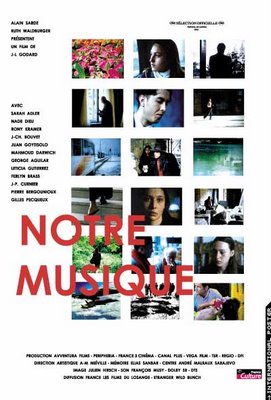
NOTRE MUSIQUE
France, 2004, 80 minutes, Black and white and Colour.
Directed by Jean Luc Godard.
80 minutes of Jean Luc Godard, 21st century style. The champion of French cinema of the 1960s, the ideologue of cinema as art as well as teacher, the experimentalist of more recent decades, now seems to have some peace despite his heartfelt detestation of war. While music is key to the experience of this film, it is the images which have most impact.
Godard borrows from Dante in the structure of his film: the three kingdoms of Hell, Purgatory and Heaven. However, his 'comedy' is less than divine in the sense that he decries the inhumanity of the human race. God, however, or, at least, the transcendent is not absent.
Godard has done a lot of work on compilation films, collages of seemingly disparate images which combine to form a visually poetic study of a serious issue. His Hell is a collage of images of war, some from news, some from archives, some from the movies about war, including old cowboys and Indians, the American Civil War (and some modern American images). His Purgatory is situated in Sarajevo, evoking memories of the Serb troops in the surrounding hills a decade earlier, but showing a city coming to life again. Visitors come for conferences on literature, for lectures on text, cinema and image, Godard himself included. This provides opportunity for interesting and stimulating discussion on war, especially on the Israel/Palestine conflict. It also raises issues of how cinema works on the sensibilities and psyche of the viewers. The Heaven sequence is briefer, more some images of beauty and of hope.
Godard includes many arresting quotations like death is 'the possible of the impossible' or 'the impossible of the possible' and, from a Catholic woman executed in 1943, 'the individual seeks two, the State seeks one'. Challenging but also more accessible Godard.
1. The work of Jean Luc Godard, especially in the 1960s, his kind of film-making, narrative, ideology of cinema? The emphasis on cinematic techniques?
2. The brevity of this film, the 21st century, Godard’s changing styles, visuals? The musical score and its range? Its being chosen to accompany Hell, Purgatory and Heaven?
3. The use of the framework of Dante’s Divine Comedy? Godard’s perspective on the human condition, divinity, humanity, comedy and tragedy?
4. The overall effect of the experience of the film: visual, aural, emotional, intelligence?
5. The title, people of the 21st century, facing a new century in the light of the wars of the 20th?
6. The scope of the three parts, time, Purgatory on Earth – and the brevity of Heaven?
7. Part one: Hell: the collage, images of war, planes and tanks, battleships, explosions, gunfire, executions, people in flight, devastated countryside, villages destroyed? The silent images? The girl’s commentary about the nature of Hell? The four pieces of music? The use of newsreel footage, realism, movies about war? The truth and fiction of war? The pauses for reflection?
8. Part two: Purgatory: Bosnia, the experience of the 1990s and the war, Sarajevo as victim city? The ten years after perspective on the war? Audience awareness of what had happened in Sarajevo? The visuals of the city, the hills where the Serbs fired on the city? Contemporary transport, the airport, the buildings, exteriors and interiors, ordinary life resuming?
9. The characters within this context, Godard himself, the man from Israel and his being interviewed by Godard, his going to Israel in 1948, going to France, his military service in Israel, returning to France? The girl, Israel, Palestine, her living in New York? The various lecturers for the conferences? The staff and the drivers?
10. The discussion in the Purgatory section, on peace and war, on Israel and Palestine, on life in France? Issues of identity? The discussions about film, text, literature, images, the experience of media, communication, truth, the future of film in a digital era?
11. The despairing girl, the 21st century? The visit to the Mostar Bridge, the reconstruction, its antiquity, as symbolism of guilt to forgiveness?
12. Part 3: Paradise: its brevity, beauty, the images of water, the young woman seen in Purgatory, her self-sacrifice, peace – and the beach and the American Marines?
13. The maxims about death: “the possibility of the impossible or the impossibility of the possible”? The Catholic woman beheaded in 1943, “the individual wants two, the state wants one”? The discussion about the image of Our Lady of Lourdes, not in the popular Renaissance portraits but Bernadette recognising Mary in the icon of Cambrai? Godard and icons and contemplation?
14. The film and the experience of war, savagery, signs of hope, God, the absence of God, contemplation, harmony, life and peace?